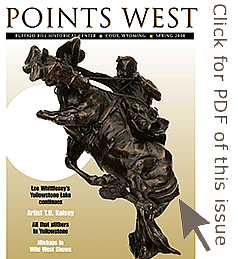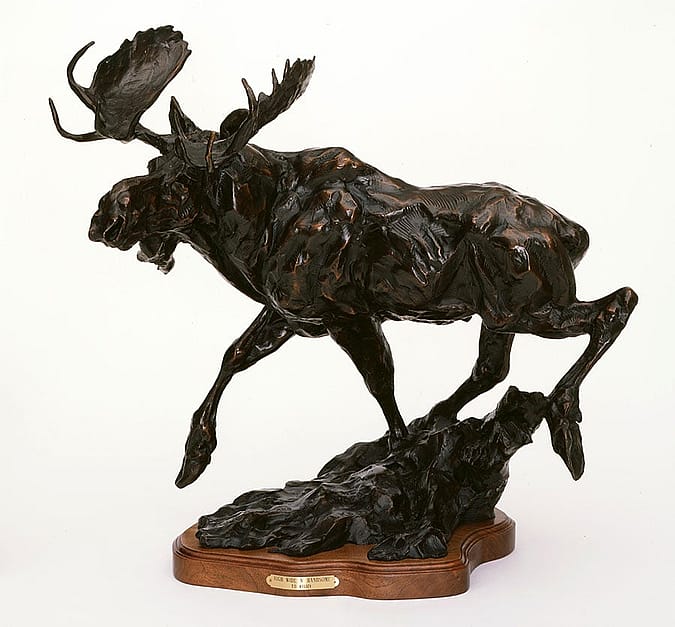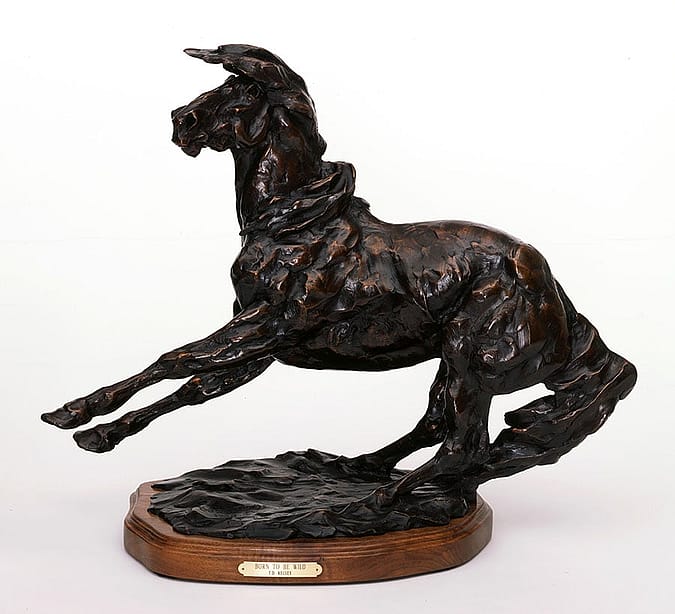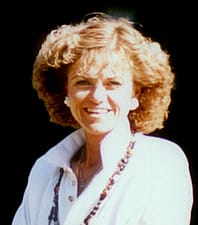
T.D. Kelsey – Points West Online

Originally published in Points West magazine in Spring 2008
T.D. Kelsey: Realist, Romantic, and Inspired Sculptor
By Mindy A. Besaw
Former Curator, Whitney Western Art Museum
Cody, Wyoming, was one of Sidni Kelsey’s favorite places in the world. It is appropriate, then, that the Buffalo Bill Center of the West received the Sidni A. Kelsey collection, donated after her death by her loving husband and artist T.D. Kelsey. The remarkable gift includes cast number one of 166 sculptures by Kelsey and encompasses the development of his career from early works to major accomplishments.
T.D. Kelsey’s artwork adds an important element to the history of American sculpture and, in particular, western American bronzes. His work draws predominantly on the western subjects of horses, wildlife, and cowboy life. These subjects are rooted in the history of America and, at the same time, support the iconography of the West in contemporary life.
Early American sculpture
American sculpture developed to maturity and technical proficiency in less than one hundred years. Early efforts in sculpture were awkward imitations of European masters without a unique American voice. In the nineteenth century, American artists studied and trained abroad, primarily in France and Italy. Artists also traveled to Europe to finish their sculptures because there were no stone quarries or bronze foundries in the United States at the time. Despite a slow start, American sculpture did progress. According to the National Sculpture Society, after the turn of the twentieth century, American sculpture matured and came to be equal to that of sculpture anywhere.
In the nascent years of American sculpture development, sculptures with western themes were initially disregarded and ignored as negative stereotypes of a “Wild West America.” Instead, Americans favored classical and European-influenced subjects. In 1893, however, new perspectives and art exhibitions at the Columbian Exposition changed the negative view. A new national consciousness brought attention to the West as civilized America. At last, western subjects were considered respectable and even became symbols of America’s national heritage. Pioneer artists of the time, such as Frederic Remington and A. Phimister Proctor, were instrumental in advancing western subjects and paving the way for future artists.
Although abstraction was the predominant artistic style in America and Europe in the mid twentieth century, realistic figurative subjects were rediscovered. A new wave of artists in the 1960s and 1970s focused on historic and contemporary western themes and wildlife. The environment was primed for Kelsey, who emerged on the art world with a unique style to convey his personal view of the West.
T.D. Kelsey, an artist in the making
Kelsey was born in 1946 and raised on a ranch outside Bozeman, Montana. He was always fascinated with art—drawing and sculpting in his spare time—but did not immediately choose art as a career. Kelsey was a rodeo cowboy, pre-med student, rancher, and airline pilot before becoming an artist. It was Sidni, Kelsey’s wife and high school sweetheart, who finally helped launch his art career. Sidni continually encouraged Kelsey to create watercolors, drawings, and sculpture. Eventually, her business savvy and planning got the couple to the point where Kelsey could quit his pilot position and devote all his time to art in 1979.
Ten years and many sculptures later, the Gilcrease Museum in Tulsa, Oklahoma, honored Kelsey as the Rendezvous Sculptor of the Year and gave him his first one-man art exhibition. Immediately, he was recognized as a new force in contemporary western sculpture. Kelsey’s sculpture is based on his interest in wildlife conservation, his rodeo career, and ranch life. With no formal art training, Kelsey relies on observation and firsthand experience for the accuracy in his work.
Wildlife emerge in paintings and sculpture
Kelsey is known as an animal artist above anything else. In a 2002 interview for Southwest Art magazine, Kelsey said, “Animals are a lot easier to be around [than people]; with them, what you see is what you get.” Kelsey’s wildlife sculpture derives from the nineteenth-century French animalier tradition. Historically, animals did not appear in sculpture until about 1870 because it was thought that a mere animal could not inspire and enrich the mind as effectively as classical idealized humans.
In opposition to this, a movement developed in the late nineteenth century that concentrated on nature and animals to represent the ideal. Painters focused on landscape subjects, and sculptors focused on animals. These animalier sculptors highlighted animals as worthy subjects, and they portrayed animals in vivid and naturalistic poses, making them animated and dramatic. American artists learned about the animalier tradition while studying art in Paris. In turn, as the sculptors returned home, animals became a popular subject for American sculpture.
Initially, the popularity of wildlife sculpture was a reaction against the increasing urbanization of life in the twentieth century. People revered the beauty and spontaneity of creatures in the wilderness because the animals were seen as living outside the constraints of contemporary society. As such, they were a symbol of freedom for city dwellers. Animals of the western frontier are among the most important wildlife subjects. Bison, wild horses, and longhorn cattle became symbolic of America as a whole.
Nature and animals
Part of the continued appeal of wildlife sculpture today is America’s renewed interest in ecology. The western frontier has vanished; natural resources are limited; and great herds of buffalo and longhorn cattle have been reduced to remnants of memory. Kelsey’s love of animals came first from his life in the West. However, his interests have expanded beyond the borders of the United States. He has studied wildlife in countries such as South Africa, Mexico, India, Zimbabwe, Tanzania, and New Zealand, to name only a few.
Kelsey expresses his appreciation for nature through the animals he represents. His keen sense of observation translates to the sensitivity and spirit of his subjects. C.E.O. personifies the bison as a powerful and influential animal of the plains. The viewer immediately recognizes the subject of the solitary male bison and his feathered companion, as well as the strength and confidence of the animal. Kelsey’s signature expressionistic style and rich modeling give immediacy to the work. The texture of the sculpture takes on a life of its own with the play of light and shadow over the surface.
Another superb example of Kelsey’s style is High, Wide & Handsome. The whimsical title re-emphasizes the personality of a vain moose who seems to be impressed with the knowledge of his own beauty. Kelsey captures the moose in his natural stride. The bronze surface is animated with the gestures and strokes of Kelsey’s fingers—imprinting hints of anatomy and muscles, yet eliminating the fussy details.
Kelsey often renders animals on a larger-than-life-size scale. His monumental sculptures grace the gardens of many museums, private corporations, and public parks across America. When working in a large scale, the same principles that are used in small scale sculptures apply to Kelsey’s work. The animals retain the expressionistic surface, texture, and movement.
For Art of the West magazine in 2003, Kelsey explained, “As representational artists, we can stretch the truth but not break it. It also has to have an aura about it that draws people’s feelings or attention to it. It has to develop its own spirit.” Testing the Air is a larger than life-size sculpture of an elk that sits atop a berm on the grounds of the Center [ed.: the sculpture was moved inside the Whitney Western Art Museum in 2009]. The elk throws its head back as it struts forward. The sculpture draws attention by its mere size and presence as well as its lively personality.
Sculpting the western horse and cowboy
More than any other animal, the horse is the foremost symbol of the American West. Western art scholar Patricia Broder recalled that thousands of mustangs ran free on the plains in the eighteenth and nineteenth centuries, and said that “to many, the mustangs symbolize the freedom and exhilaration of Western life.”
Indeed, horses are one of Kelsey’s favorite subjects. On his ranch in Texas, he trains and shows cutting horses and maintains a herd of wild horses. Kelsey sculpts his horses with ease and spontaneity, acquired from a lifetime of working with the animal. Born to Be Wild was modeled from a wild horse. The horse rears up on his back legs as if startled in mid-sprint. The mane and tail blow in the opposite direction of the horse’s action, creating a dynamic tension with lines and motion.
The cowboy is inarguably another symbol of the West
Starting in the 1890s, sculptors have worked to recreate all phases and moods of the cowboy. Kelsey is a cowboy artist—someone who has worked and lived as a cowboy and portrays incidents from ranch and rodeo life based on personal experience. On his ranch, Kelsey raises longhorn cattle in addition to his horses. Through his sculpture, Kelsey has captured many facets of cowboy living: from cattle drives, to quiet, tender moments between man and horse, to the action-packed rodeo.
Dirty Dancing illustrates a cowboy on a bucking bronco. Kelsey, like many other artists of the American West, enjoys the challenge of capturing the action and tension of cowboy and horse at the height of exertion and extension. This sculpture exemplifies Kelsey’s realist and romantic natures. As a realist, he demonstrates events and observations from his own life and portrays them with accuracy and authenticity. As a romantic, he glorifies the West in which he lives—not the West of the past, but the exhilarating West of today.
The essence of inspiration
This brings us full circle to the real inspiration in Kelsey’s work. His true inspiration comes not from the western wildlife or the rodeo, but from his late wife, Sidni. “If my sculpture is worth a second look, it’s because of Sidni, without a doubt. If it weren’t for her I wouldn’t be an artist,” Kelsey says.
Sidni loved art but was not an artist herself. Fortunately, she was a very good collector, especially of her husband’s work, but that of other artists, too. As Kelsey recalls, “It was paramount to Sidni that she keep the number one castings throughout my career. Sometimes it was very difficult but she never faltered.” Sidni was in Cody among friends on the day she passed away in 2000, but her spirit is still alive in Kelsey’s work. Sidni is the reason for Kelsey’s career as an artist and, therefore, we have Sidni to thank for her vision and generous gift of sculpture to the Center.
The story of western American sculpture has only just begun. By the turn of the twenty-first century, American sculpture had undergone a national renaissance. Public interest in figurative work was revived, and the creation of public sculpture was on the rise. With the addition of the Sidni A. Kelsey collection to the historical center, the Whitney Western Art Museum can better illustrate the development of western American sculpture, in addition to highlighting the work of T.D. Kelsey, one of the most talented contemporary sculptors in the West today.
About the author
Mindy A. Besaw is a former Curator of the Whitney Western Art Museum. She came to the Whitney from the Denver Art Museum, where she was Curatorial Associate at the Institute of Western American Art. She earned her BFA in Art History at the University of Illinois, Urbana-Champaign and an MA in Art History at the University of Denver. She also served as Adjunct Instructor in Art History at the University of Colorado, Denver. With a background in contemporary art, as well as art of the West, Besaw’s special interest is to connect contemporary western art with its historical counterpart. She became Curator at Crystal Bridges Museum of American Art in Bentonville, Arkansas, in 2015.
Post 171
Written By
Nancy McClure
Nancy now does Grants & Foundations Relations for the Center of the West's Development Department, but was formerly the Content Producer for the Center's Public Relations Department, where her work included writing and updating website content, publicizing events, copy editing, working with images, and producing the e-newsletter Western Wire. Her current job is seeking and applying for funding from government grants and private foundations. In her spare time, Nancy enjoys photography, reading, flower gardening, and playing the flute.


















